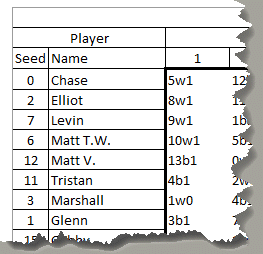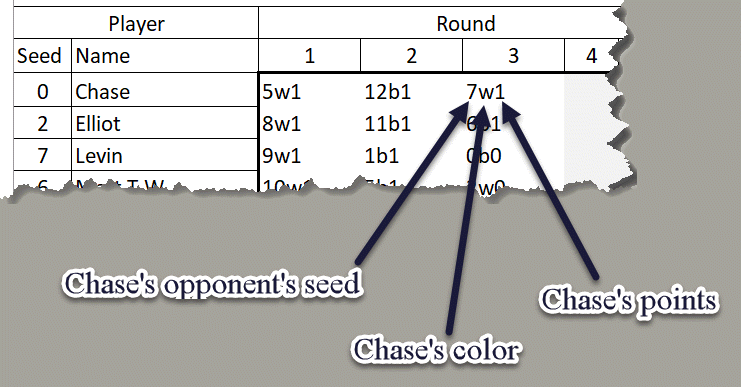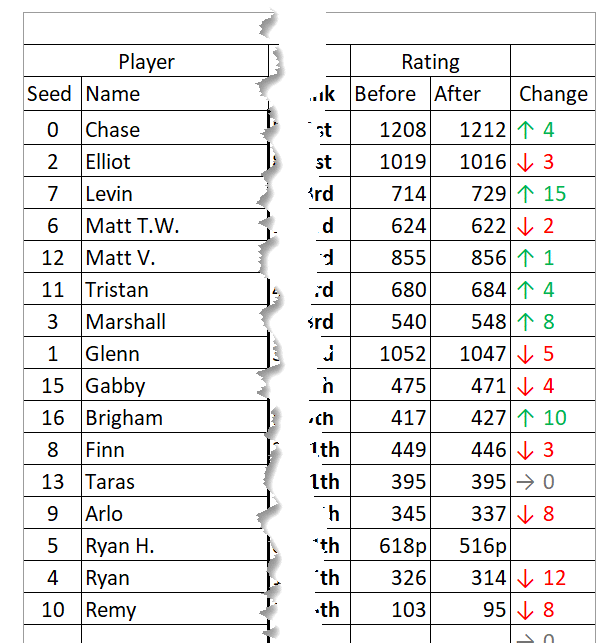Every week, I publish a table with tournament results. If you’ve ever looked at it, and wondered what the heck you’re looking at, this is post is for you.
Each tournament result table has the header shown in the figure above. On the very top is the date on which the tournament occurred.
Player data
On the left is player identifying information, center is round information, and right is rating information.
In the player section, there are two pieces of data. The player’s name, and the player’s seed. When we first started running these tournaments, players were assigned a seed based on their pre-tournament rating. It turned out that this number was only ever used as a unique identifier for the round information section I’ll address in the next section, and so over time, it turned into simply the order in which players arrived to play. In tournaments in the future, it is automatically populated with the order a player joined The Rookery, and should be consistent from one tournament to the next.
Rounds
Next we come to the part that most of you probably have trouble reading.
The round information. For the purpose of this explanation, I have circle two specific entries that are referring to the same game. In Round 3, Chase played Levin. Chase was white, Levin was black, and Chase won. Now I’ll dissect how I know that from these entries.
Notice the entry is in the column for round 3 and Chase’s row. So we know the data in the box is for Chase’s game in round 3. His opponent’s seed, the first number, is 7. Looking at the far left column, we see that #7 is Levin. So we know Chase played against Levin. Next we have a letter. It will always be either a ‘w’ or a ‘b’ and signifies the color of the pieces played by the player whose row we’re in. So Chase played with the white pieces. Finally, we have the number of points awarded to that player. In all chess tournaments, 1 point is awarded for a win, 1/2 point is awarded for a draw, and 0 point is awarded for a loss.
If you look at Levin’s row, you see the reciprocal of this information, Levin played #0 who is Chase. Levin played as black, and Levin was awarded 0 points.
There are a few other things you might see in these boxes. Some are much more common than others.
H = Half point bye
F = Full point bye
U = Zero point bye
X = Forfeit game
Half point byes are very common. It essentially allows a player to skip a round, commonly because they came late, or left early. For the purpose of tie-breaks, earned points, those awarded for completed games, always beat points awarded via a bye. Often tournament directors will specify ahead of the tournament how many half point byes are permitted. And a player voluntarily skipping a round, who has half point byes available is awarded one.
Full point byes happen less often, but still in about half of tournaments; more than half of tournaments in our club. The most common reason this awarded is that there is an odd number of players. The player who was made to sit out the round involuntarily is awarded a full point bye. In USCF tournaments the lowest rated player who has not already had a full point bye is asked to take a full point bye. In the Rookery, Chase or I will commonly volunteer to take it so that all the kids who want to play will get a game.
Un-played rounds are relatively uncommon. They occur when a player requests a round off, or is not present for their game and has exhausted all their half point byes.
Forfeit game has only happened once in the Rookery. And in that case it was for a player who intentionally tampered with the board/clock such that the game could not be continued. Their opponent was awarded the point as if they had won the game, and the player who tampered with the game received an ‘X’ denoting that they had lost the game by forfeit. The other reason why this can happen is that a player is caught cheating. This has never happened at the Rookery.
Points
Points are used to pair players up. In the first round, pairing is based on a player’s pre-tournament rating. Thereafter, players are paired against other players who have the same number of points as they do. This is the purpose of the byes that award points. The idea is that you still converge on a group that’s roughly your skill level, even if you’re unable to play a round for one reason or another. Points are also used to decide the winner of the tournament. If players have the same number of points, there are a number of tie-breaks used.
But, our players tend not to care so much about that as it turns out. I think I’ve been asked who won a given tournament less than a dozen times. What the players care about is their rating.
Rating
This section is pretty self explanatory, but we’re here, so I’ll explain it anyway.
There are three columns pertaining to a player’s rating. The first is their rating going into the tournament. It’s largely used to pair players in the first round and becomes less influential as the rounds progress. The second column is the player’s post tournament rating. This is their new rating after all the games they played in the round section are taken into account. Finally, the third column is the change from the first to the second.
I’m going to dive into what a rating is used for, what it measures, how it measures it and how all that is calculated in a future post. If you found this explanation helpful, and if you want to catch the explanation of the Rookery’s rating system, share this post with a friend, and subscribe so you don’t miss the next one.






